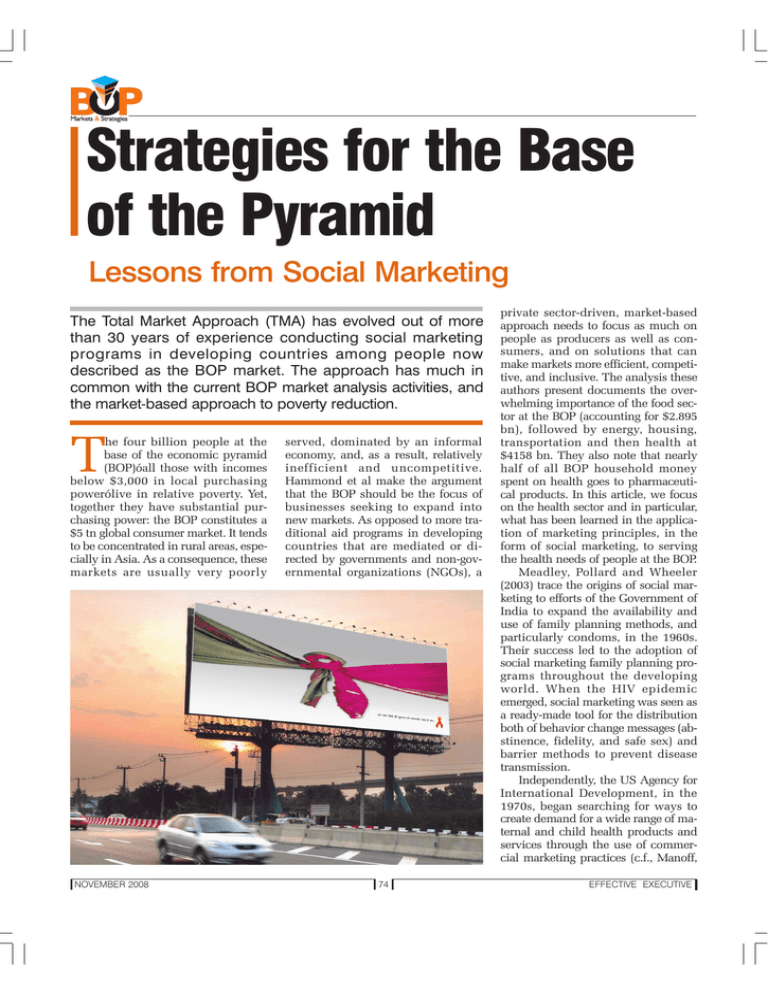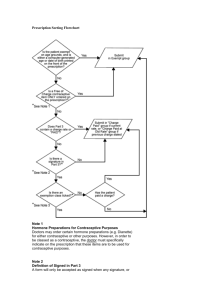Strategies for the Base of the Pyramid Lessons from Social Marketing
advertisement

Strategies for the Base of the Pyramid Lessons from Social Marketing The Total Market Approach (TMA) has evolved out of more than 30 years of experience conducting social marketing programs in developing countries among people now described as the BOP market. The approach has much in common with the current BOP market analysis activities, and the market-based approach to poverty reduction. T he four billion people at the base of the economic pyramid (BOP)óall those with incomes below $3,000 in local purchasing powerólive in relative poverty. Yet, together they have substantial purchasing power: the BOP constitutes a $5 tn global consumer market. It tends to be concentrated in rural areas, especially in Asia. As a consequence, these markets are usually very poorly NOVEMBER 2008 served, dominated by an informal economy, and, as a result, relatively inefficient and uncompetitive. Hammond et al make the argument that the BOP should be the focus of businesses seeking to expand into new markets. As opposed to more traditional aid programs in developing countries that are mediated or directed by governments and non-governmental organizations (NGOs), a 74 private sector-driven, market-based approach needs to focus as much on people as producers as well as consumers, and on solutions that can make markets more efficient, competitive, and inclusive. The analysis these authors present documents the overwhelming importance of the food sector at the BOP (accounting for $2.895 bn), followed by energy, housing, transportation and then health at $4158 bn. They also note that nearly half of all BOP household money spent on health goes to pharmaceutical products. In this article, we focus on the health sector and in particular, what has been learned in the application of marketing principles, in the form of social marketing, to serving the health needs of people at the BOP. Meadley, Pollard and Wheeler (2003) trace the origins of social marketing to efforts of the Government of India to expand the availability and use of family planning methods, and particularly condoms, in the 1960s. Their success led to the adoption of social marketing family planning programs throughout the developing world. When the HIV epidemic emerged, social marketing was seen as a ready-made tool for the distribution both of behavior change messages (abstinence, fidelity, and safe sex) and barrier methods to prevent disease transmission. Independently, the US Agency for International Development, in the 1970s, began searching for ways to create demand for a wide range of maternal and child health products and services through the use of commercial marketing practices (c.f., Manoff, EFFECTIVE EXECUTIVE Strategies for the Base of the Pyramid 1985). In the US, and subsequently in Europe and Australia, social marketing was introduced into public health practice (Lefebvre & Flora, 1988) where it has been used extensively to promote health behaviors such as the prevention and cessation of tobacco use, fruit and vegetable consumption and prevention of illicit drug use among many others. Applying commercial marketing practices to public health services developed after these two developments. Its primary use has been to develop franchise procedures to increase the awareness of family planning; improve the availability and accessibility of contraceptive supplies and services; and promote cost recovery from retailers and fee-paying clients through the application of commercial strategies to the promotion of contraceptive methods (Ruster, Yamamoto & Rogo, 2003) (see Exhibit). Since these initial efforts, social franchising, as it is often known by in international development, has expanded to include many different types of services and products. In the prototype of family planning services, social franchising supports long-term contraceptive methods and broader reproductive health care and requires the participation of trained health providers. Networks of providers, or franchisees, are service producers in the clinic franchise system; they create standardized services under a franchise name. The result is a network of service providers offering a uniform set of services at predefined costs and quality of care (Stephenson et al, 2004). In their analysis of successful strategies for the BOP, Hammond et al (2007) find support for localizing value creation through franchising ñ agent strategies Successful models exist in numerous business sectors of the BOP market including health care information and communication technologies, food (agent-based distribution systems), water (community-based treatment systems), and energy (mini-hydro-power systems) that involve building local ecosystems of vendors or suppliers ñ or by treating the community as the customer. Successful models exist in numerous business sectors of the BOP market including health care (franchise and agent-based direct marketing), information and communication technologies (local phone entrepreneurs and resellers), food (agentbased distribution systems), water (community-based treatment systems), and energy (mini-hydro-power systems). Dr R Craig Lefebvre is an architect and designer of public health and social change programs. He is an Adjunct Professor of Prevention and Community Health at The George Washington University School of Public Health and Health Services. Most recently he was the Chief Technical Officer at Population Services International (PSI) where he led PSI’s technical teams in capacity building, HIV, malaria, child survival and clean water programs, reproductive health, and social marketing as well as its research and metrics functions. An internationally recognized expert in social marketing and health communication, Craig’s work has addressed a multitude of health risks, aimed at various diverse audiences, and often featuring local implementation strategies. He is the author of over 60 peer reviewed articles and chapters in the areas of community health promotion, social marketing and behavioral medicine and has made over 175 presentations at professional meetings and invited venues. Craig has held faculty appointments at the University of Virginia, Brown University, Johns Hopkins University and the University of South Florida. He was elected a member of the American Academy of Health Behavior in 2003. He received his PhD in Clinical Psychology from North Texas State University and completed post-doctoral fellowships in Behavioral Medicine at the University of Virginia and the University of Pittsburgh. NOVEMBER 2008 Franchisers in the health sector, often supported by international donors and NGOs, establish protocols; provide training for health workers; certify those who qualify; monitor the performance of franchisees; and provide bulk procurement and brand marketing. Similarly, Stephenson and colleagues (2004) found that reproductive health service providers may be motivated to join a franchise network 75 for their perceived operating advantages of increasing their revenue; providing staff training opportunities; expanding their service capabilities; and improving the ability to reach more and poorer people with their services. Their data also support the notion that franchises can result in increased client volumes and range of family planning brands, and perhaps achieve greater efficiencies as demonstrated by the lower staff: client rations in franchise clinics in comparison with private ones. Several health franchising operations (Greenstar in Pakistan, Kirsunu Medical Education Trust in Kenya, and Well_family Midwife Clinic Network in the Philippines) have demonstrated that they can rapidly expand basic health services to poor people, capture economies of scale, and reduce the information asymmetries that often adversely affect the quality of care. Whether these programs can be financially sustained in the longer term is still an open question. What Stephenson et al suggest, and one that is actively pursued by a number of NGOs, is to expand service offerings to include the treatment of malaria, tuberculosis, provision of point-of-use water products, and other essential products and medicines. As these systems expand both their product and service portfolio, and their number of EFFECTIVE EXECUTIVE Strategies for the Base of the Pyramid Exhibit The Benefits and Limitations of Franchising Health Services Identified by Ruster, Yamamoto & Rogo (2003) Benefits ! Quality control and consumers ! Bulk supply (economies of scale) of supplies and services ! Opportunities to develop professional networks and referral streams ! Large scale marketing and promotion (rather than micro-marketing in only local markets) ! Built-in incentives for providers/owners Limitations ! Asymmetry of information between services providers ! Difficulty and cost of monitoring provider performance ! Ability to standardize protocols for care provision ! Training and education of owners – requires technical and business skills to be successful outlets, developing cost-effective reporting and monitoring systems and implementing and supply chain management systems, perhaps through the use of wireless technologies, becomes a critical need. The Total Market Approach Shortcomings of the classic social marketing approach of providing subsidized products and servicesó most notably the possible impact on private sector development and the lack of clear exit strategies (independence from donor subsidies)óhave led to the exploration of new models that bridge, and even coalesce, the gaps among the public, NGO and private sectors. These newer approaches examine how the public provision of free goods and services, the classic social marketing or NGO model of modest costs for commodities passed on the users (with no cost recovery for distribution and promotion), and the private sector model that recovers all associated costs plus a profit margin can be expanded to meet the larger public policy goals of sustainable universal access (ability to generate and operate on local funding streams independently of international donors). One of these models, the Total Market Approach (TMA), has a number of offerings and insights that will benefit companies looking to engage the BOP. The TMA to the delivery of commodities and services within low-income countries sets out to establish NOVEMBER 2008 equitable, efficient, sustainable and affordable markets for health commodities and services across all populations. Its objectives are to ensure subsidies are targeted to those who are most in need of them, that the very poor are equitably served, and that sustainable commercial markets are created. It establishes clearly defined market segmentation strategies within which each player in the supply chain those who favor ëmarket-based solutionsí as to whether market-based approaches will have negative impacts on achieving the goals of universality and long-term sustainability (i.e., they will favor those people with the resources to pay for goods and services). Conversely, there is also the concern that by continuing the provision of essential goods and services only through the public sector, the private sector is crowded outóresulting in an unsustainable marketplace as well. The TMA model embraces the policy objectives of the public health or sector approach that markets for socially beneficial goods and services do exist in some form in all settings, and the realities that poor and vulnerable populations (BOP) must be protected from market failures. Hanson et al include five likely sources of market failures which are: 1. Externalities where added social benefits may favor some goods and services over others ñ for instance, barrier methods for family planning also protect against the trans- The TMA model embraces the policy objectives of the public health or sector approach that markets for socially beneficial goods and services do exist in some form in all settings, and the realities that poor and vulnerable populations (BOP) must be protected from market failures works to enhance demand and effectively target supply across the total marketóthe public sector, the NGO/ community sector and the commercial sector, and across all donors (Pollard, 2006). A paper by Hanson et el (2001) captured many of the tensions and dynamics in seeking to expand the market for contraceptives that will also face other social entrepreneurs and organizations working at the BOP. Based on their analysis, we understand that universal and sustained access to contraceptives and other health products is usually a national and international policy priority. However, there is a debate among proponents of the socalled ëpublic health approachí and 76 mission of sexually transmitted diseases (STIs) and HIV, which may lead in some contexts where there is high prevalence of STIs and HIV/AIDS to favor the use of these methods over pills and injectables. 2. Poverty whereby the willingness and ability to pay any of the costs associated with products and services may not exist. 3. The merit goods should be available to all people. Here, there may be national targets for use of family planning products and services that are believed to be optimal for health and are independent of the externalities and level of poverty. EFFECTIVE EXECUTIVE Strategies for the Base of the Pyramid 4. The availability of information about the need and benefits for products and services will also be a determinant of whether there is sufficient demand for them. Public sector approaches view this as an especially important issue for individual decision-making, while private sector usually views this as confined to the promotion of their own brands. 5. Gender equity recognizes that there are household disparities in access to information and resources and constraints on decision making that disproportionately affect women. Public goods and services also need to address these issues and their impact on the nature of the total marketónot just the extant one. In practice, TMA is an approach that aims to influence health and health-related behaviors equitably and efficiently by financing and coordinating interventions that may work across one or more sources of supply (public, NGO or private sector). It also uses communications/regulatory/financing or other strategies that can influence behavior directly or indirectly via changes in product and service delivery and/or opportunities to engage in healthier behaviors. It is a process that includes population and service delivery monitoring; performance evaluation of public, nongovernmental and commercial actors in delivering products and services to different market segments; and efforts to shift consumers with sufficient purchasing power away from wholly or partially subsidized supply sources using segmentation strategies based on their willingness to pay. Collecting and analyzing these data are one of the many challenges for making TMA work. Chapman, Rabary and Rharinjatovo (2008) have shown how a method of segmentation and performance monitoring based on TMA principles can be successfully applied to health marketing activities. Their segmentations scheme is based on measures of vulnerability, current consumption, equity-based meaNOVEMBER 2008 sures, source of supply preference, physical access to goods and services and psychosocial determinants of consumption, including willingness to pay. Based on these segmentation criteria, the authors identify five TMA performance measures. The first measure, effectiveness, is defined as an increase in healthier behaviors or in the consumption of health products and services as a result of social marketing or other interventions. They note that when a specific behavior, product or service is the focus of the program ñ and other alternatives also exist for people to chose from (e.g., other brands of condoms justed Life Years (or DALYs) as a common way to assess program impacts and from there develop standards for what constitutes a minimum threshold for ëcost-effectivenessí for interventions aimed at specific diseases (see Eberwine-Villagr n, 2007 for examples). Equity is defined as the absence of a difference in health behaviors, product availability and use, or service accessibility and use across socioeconomic strata. For working on BOP, equity is a major policy interest and one that may be incumbent on businesses to demonstrate or at least be cognizant of as they develop and expand their offerings. Other social TMA approach aims to influence health and health-related behaviors equitably and efficiently by financing and coordinating interventions that may work across one or more sources of supply or different types of service providers), then ëhaloí and ësubstitutioní effects should also be measured. ëHalo effectsí would be seen, for example, when it is not just the sales of the promoted condom that show an increase, but the category of condom sales also record an increase; this would mean that other brands also have a rise in sales. Substitution effects are especially important in the health arena where the adoption of new behaviors or products might lead to an increase in risky behaviors, such as the use of condoms leading to more risky sexual encounters based on the belief that one is now completely safe from contracting STDs and HIV. The second performance measure, cost-effectiveness, can be estimated from resources dedicated to the project from all sources divided by the actual or estimated impact of the project on behavior change, health status or disease morbidity and mortality. Cost-effectiveness can be compared across different projects that employ similar methodologies to develop their estimates. There is also a movement to employ Disability Ad78 inequities that can be of interest, depending on the nature of the problem being addressed and those who may suffer disproportionately from it or lack access to solutions, include gender, age or education. The fourth measure, efficiency, is defined in terms of trends in market share between commercial and subsidized sources of supply. An increase in commercial market share as the result of a social marketing or other interventions is evidence that the commercial market is being ìcrowded in.î Alternatively, a decrease means the commercial sector is being ìcrowded out.î How this balance of market supply is achieved, and what the right mix of markets is for particular social and health issues, is a matter of local context and judgment. The fifth performance measure, access, is defined in terms of a populationís proximity to the merit good or service and the presence of psychosocial determinants of consumption and purchase. Here the use of geographic mapping systems have much to offer in spatially plotting out changes in access as a result of proEFFECTIVE EXECUTIVE Strategies for the Base of the Pyramid gram initiatives, though user perceptions of whether physical location translates to easier and more convenient access should also be considered. The authors used TMA to analyze the hormone contraceptive market in Madagascar where social marketing of injectable and oral contraceptives began in 1998 by Population Services International (PSI), a non-governmental organization. By 2004, two PSI branded products were available (through pharmacies, drug stores, private medical offices, workplaces and community-based non-governmental organizations). Public sector injectable and oral contraceptives were distributed through government facilities at a cost of approximately $0.66 per year. Commercially available oral contraceptives were available primarily through pharmacies at about $30.00 for a one yearís supply. Two cross-sectional surveys were conducted in October/November of 2004 and 2006 among a representation of the national population of women aged between 15 and 49 years to assess the TMA performance measures (how well the hormonal contraceptive marketplace met the criteria of effectiveness, cost-effectiveness, equity, efficiency and access). From 2004 to 2006, overall contraceptive use increased by 5% to nearly 24%, with almost all the growth stemming from increases in injectable and oral contraceptive use (as opposed to other methods available in the market). The increase in injectable contraceptive use was significant over the two years, but the increase in the socially marketed injectable brand (PSI) contraceptive was not. Total oral contraceptive use did not increase significantly; the use of the socially marketed oral contraceptive did. There was increased inequity in rates of use across socioeconomic strata, yet inequity in use among women using social marketing brands decreased significantly over the two years. Market shares for social marketing (approximately 45%) and public sector brands (10%) did NOVEMBER 2008 not change over the period, but nearly half of respondents could not recall the contraceptive brand being used. Perceived availability of contraceptives did not increase over the period, but perceptions of social support, favorable attitudes towards contraceptive use, improved beliefs about contraceptive use and risk perceptions that lead to an increase perceived need to use contraception did. Willingness to pay for injectable and oral contraceptives declined significantly, by more than 50%. Exposure to family planning campaigns resulted in significant increases in rates of contraceptive use and was greater erty reduction. Both the TMA and BOP approaches reinforce an approach to poverty reduction that is framed in terms of enabling opportunity and less in terms of aid. A successful market-based approach would bring significant new private sector resources into play, allowing development assistance to be more targeted to the segments and sectors for which no viable market solutions can presently be found. As the TMA approach says, the active entry of the private sector into providing goods and services to the poor needs to be supported, but their work needs to be assessed and evaluated The active entry of the private sector into providing goods and services to the poor needs to be supported, but their work needs to be assessed and evaluated in the larger context of the marketplace among wealthier quintiles than poorer ones. The authors conclude that significant increases in hormonal contraceptive use from 2004 to 2006 and exposure to social marketing family planning campaigns and activities evidence that the overall social marketing intervention has been effective. The results also demonstrate the presence of a halo effect; that is, the social marketing campaigns increased the use of all hormonal contraceptives significantly, but there was no specific impact on the use of social marketing products. More importantly, from a public health perspective, the social marketing interventions significantly reduced inequities in the profile of its own users. Conclusion The TMA approach has evolved out of more than 30 years of experience conducting social marketing programs in developing countries among people now described as the BOP market. The approach has much in common with the current BOP market analysis activities, and the market-based approach to pov79 in the larger context of the marketplace. This assessment needs to be focused on how the public, NGO and private sectors contribute by their unique and complimentary strengths to attain equitable, efficient, sustainable and affordable health and health care across the population. In their analysis of the global income pyramid and who will profit where in the years to come, Reid and Block (2008) state that technological changes are allowing companies to pursue the profitable marketing of goods and services in the BOP. Corporate restructuring will play a significant role as companies adapt to and profit from these shifts in global income and consumption patterns. When this restructuring takes place, companies should look at the lessons already learnt from social marketing and the guidance of the Total Market Approach as they weigh their options. ©2008, Dr R Craig Lefebvre. All Rights Reserved. Reference # 03M-2008-11-11-01 EFFECTIVE EXECUTIVE






